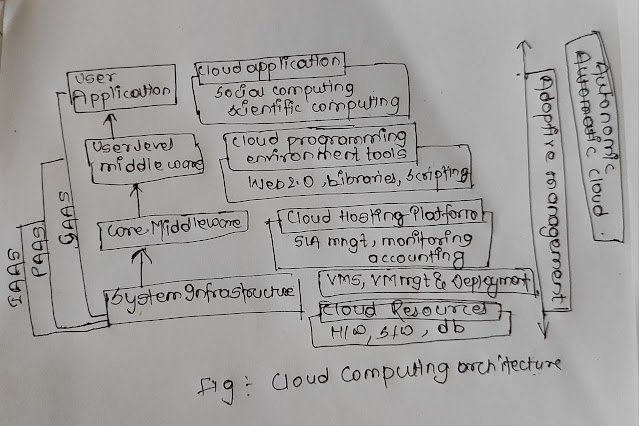Explain the architecture of Cloud computing in detail.
Architecture of Cloud computing
- Cloud computing is utility-oriented and Internet Centric way of delivering IT services on demand.
- cloud computing architecture includes
i) infrastructure as a service
i)platform as service
iii) software as a service
From the figure above, we will discuss
i) infrastructure as a service
ii)platform as service
iii) software as a service
iv) user-level middleware
v) User application
vi) core middleware
vii) system infrastructure.
1. IAAS
It provides access to fundamental resources such as physical machines, virtual machines, virtual storage, etc.
Characteristics:
- virtual machines with pre-install s/w
- virtual machines with preinstall os
- on-demand availability of resources
- Allow copying of the particular data at different locations.
- resources can be easily scaled up and down.
2. PAAS:
- platform as a service offers the runtime environment for the application. It offers development and deployment tools
- Required to develop the application.
characteristics:
- pass offers a browser-based development environment.
- provides built-in security, scalability, and web services.
- provides built-in fools for defining workflow, approval process, and business values.
- easy to integrate with other applications some platform
- provides a web services interface to connect applications outside the platform.
3. SAAS
Allows providing s/w application as a service to the end users. software is deployed on the host service and is accessible via the internet.
characteristics :
- software available on the internet
- Software applications are maintained by vendors
- License to s/w may be sup subscription based.
- It is cost-effective
- Available on demand.
4. User applications :
- It includes cloud applications through which endures get interact
- there may be a different application like scientific, gaming
- eg: Gmail, facebook.com, etc.
5. user-level middleware
- includes cloud application programming environment and tools
- different types of programming and tools depend on user application
- eg web2.0, libraries, scripting, etc.
6. Core middleware
- It includes cloud hosting platforms.
- It manages the quality of services.
- It executes management.
7. System infrastructure
- It includes cloud resources.
- It store hardware, software.
- Database, and services are part of it.




Comments
Post a Comment